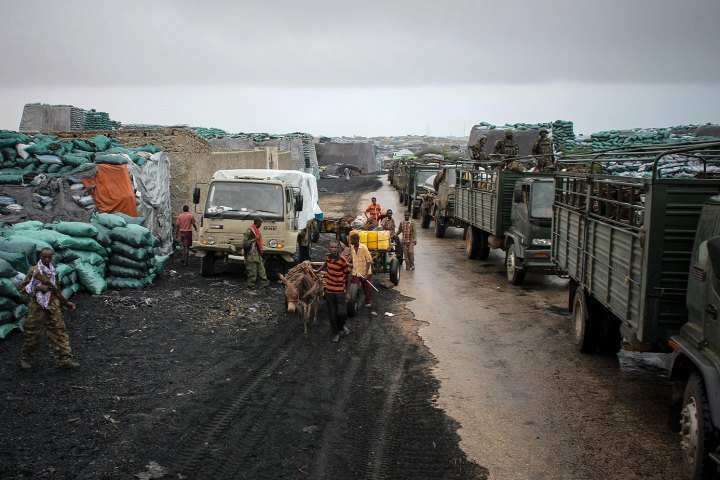Widgetized Section
Go to Admin » Appearance » Widgets » and move Gabfire Widget: Social into that MastheadOverlay zone
Why Charcoal May Endanger Somalia’s Best Hope for Peace
On a Monday afternoon in October, in a warehouse in the southern Somali port of Kismayo, I attended a meeting on the future of Somalia. On one side: 20 Somali traders sitting on grass mats and wearing sandals, sarong-like wraps, short-sleeved shirts and embroidered scarves. On the other, in plastic chairs: officers from the Kenyan and Somali armies and the allied Ras Kamboni militia who, fighting under the banner of the African Union Mission in Somalia (AMISOM), ousted the al-Qaeda-allied al-Shabab from southern Somalia’s biggest city a few weeks earlier. AMISOM’s offensive against al-Shabab, kicking them out of the capital Mogadishu in August last year, then capturing Kismayo, were a body-blow to the Islamists and represent the best chance for peace in Somalia since the collapse of the last central government in 1991. But in Kismayo, as I discovered, as the only Western journalist to enter the city, the joy of victory had quickly soured. At stake at the October meeting, I was told, was nothing less than peace in southern Somalia, and possibly the whole country. And the key? A giant pile of burnt, dead wood.
Great progress has been made in Somalia over the last 15 months. Al-Shabab has suffered a series of military setbacks, a new president has been chosen, a slim-line government has been formed, famine has abated and Mogadishu is enjoying a newfound optimism after decades of destruction. The turnaround seems dramatic and it is, given 21 years of war and famine. But the truth is that while those tragedies gave the world an impression of a failed state without hope, the enduring reality of daily life during the fighting for many Somalis – and at the heart of many of Somalia’s conflicts – was always business. Camel trading, mango growing, mobile telecoms and, of course, arms dealing all thrived in the war years. And few businesses were as big or profitable, or as tough, as charcoal.
(PHOTOS: Somalia in Transition)
The charcoal business grew exponentially under al-Shabab. While the group did not itself invest directly in charcoal, it levied taxes at every stage of the process, from production to export. U.N. investigators reckoned the group earned $25 million from the trade last year. So in February the U.N. banned charcoal exports in a bid to cut off funding for al-Shabab. Since then, charcoal has been piling up. There are now more than four million sacks of the stuff at Kismayo’s southern entrance, stacked in immense house-sized blocks of dirty burlap bags lining the soot-covered road. Its value is estimated at up to $40 million.
A boon to a post-conflict economy, perhaps? Anywhere but Somalia. Matt Bryden, director of the Nairobi-based think tank Sahan and a former head of the U.N. Monitoring Group, which analyzed the charcoal trade, said a handful of traders controlled the trade and all of them had links – commercial, if not necessarily ideological – to al-Shabab. “There’s no question that this is an al-Shabab linked industry and those relationships don’t evaporate overnight,” he said. One Western diplomat with close knowledge of the situation told me that any sale of charcoal, even the relatively small amounts already known to be leaving Kismayo, means “the financial circuit has not been interrupted. The major financing for al-Shabab continues.”
All of which might make a resumption of the trade sound like a bad idea. But the businessmen, and some of al-Shabab’s enemies – all of them well-armed – disagree. The city was captured partly with the aid of Ras Kamboni, an ethnic Ogadeni clan militia run by Sheikh Ahmed Madobe. Madobe is a tall, bearded warlord who has himself undergone a remarkable rebirth. Five years ago he was an Islamist commander targeted by American missiles. Today he is a crucial ally in the war on al-Qaeda in Somalia. He wants the charcoal trade re-started. “The economy of this city is 90% charcoal,” Madobe told me. “Businessmen have invested a lot of their money and the U.N. embargo is blocking it. The stockpile cannot be returned to the trees. It should be sold.”
(MORE: Somalia’s Chance: Can a U.S.-Backed African Force Bring Peace?)
The dispute could have ramifications for attempts to install Somalia’s first central government in generation. Negotiations to determine the make-up of a post-Shabab southern administration, underway for a year without resolution, are now on hold, pending resolution of the charcoal dispute. As for attempts by the national government to establish its rule, earlier this month Madobe refused to meet a presidential delegation sent to Kismayo, issuing a scarcely veiled threat that he could not guarantee their safety if they entered the city. Says Bryden: “[This is] about power and resource sharing in the Jubas [the collective name for Somalia’s three southern regions]. People are looking at that big stack of charcoal and they want the profit.”
Some discern a nefarious international hand at work as well. Control of Kismayo means control of southern Somalia’s economy – and well-established, lucrative smuggling routes into Kenya, taking charcoal out and sugar in. With elections due in Kenya early next year, some suspect Kenyan politicians and military leaders of re-opening the trafficking routes to feed their political slush funds. During my time in Kismayo, a trip to the port revealed Kenyan and Ras Kamboni soldiers overseeing the unloading of cement from a cargo ship and, from the fat bellies of two wooden dhows, timber, pasta, cooking oil and sugar. The dispute over Kismayo’s mountain of charcoal may endure for a while yet. But in the end, as it [did through two decades of war, there seems little doubt that one way or another Somali business will triumph.
MORE: Dispatch from Somalia: War, but a Glimmer of Hope
By Tristan McConnell / Kismayo


Figradihiina